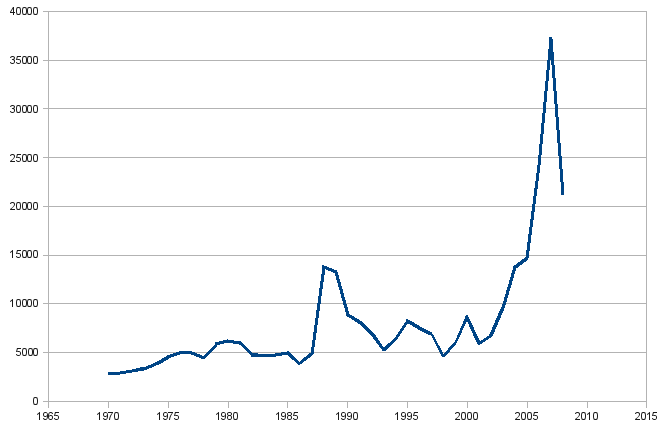| Tikalon Blog is now in archive mode.
An easily printed and saved version of this article, and a link
to a directory of all articles, can be found below: |
|
This article |
| Directory of all articles |
The Manganese Conspiracy
June 9, 2010
I was in graduate school in the mid-1970s, and as a materials scientist I learned a lot about metals and alloys. Pure metals are extremely soft in an annealed state, and they are not suitable for structural components. However, adding a small pinch of another element will change the mechanical properties of a metal dramatically, usually increasing its hardness. That's what alloying is about - knowing what to throw into the pot. It's become a science now, and many alloys are made from a long list of component metals. For example, MAR-M-247, an important nickel alloy used at high temperature, has the following composition (wt.-%): 10.0 Co, 10.0 W, 8.25 Cr, 5.5 Al, 3.0 Ta, 1.5 Hf, 1.0 Ti, 0.7 Mo, 0.15 C, 0.05 Zr, 0.015 B, Balance Ni.
Manganese is a common addition to iron-based alloys, especially in the formulation of stainless steels. Since manganese is very susceptible to oxidation, it will capture dissolved oxygen and sulfur from the melt and render a better solid. Manganese has another benefit that its sulfide melts at a higher temperature than iron sulfide, so liquid sulfide does not occur at grain boundaries near machined surfaces. Machinability is thereby enhanced. Manganese is typically present in iron-based alloys at about 8 wt-%, but there are some alloys that contain up to 15% manganese. It's conjectured that the steel used by the
Spartans for their swords was an alloy ideal for its intended purpose, since the iron ores they used had a natural abundance of manganese.
Manganese is used also as an alloying element for
aluminium. Manganese at about 1.5% gives aluminum corrosion resistance, and this particular alloy composition is used in aluminum beverage cans.
Manganese dioxide is used as a cathode in disposable batteries (Electochemists, note - A battery cathode is where the electrons go, the opposite to your nomenclature). The
US Sacagawea dollar contains manganese.

Now, back to the 1970s. My classmates and I were intrigued by news reports we had read about attempts to harvest manganese from the sea. Some of the ocean floor is littered with peach-sized
nodules that are rich in manganese and nickel. Some contain up to 30% manganese and 1.5% nickel. They are produced over the course of tens of millions of years by a slow geological process. During the 1970s, the economics of harvesting these were reasonable because of their high nickel content, but lower nickel prices eventually defeated commercialization. Looking at the nickel price trends (dollars per ton in the figure [1]), I predict that harvesting manganese nodules might be in our future.

Nickel Prices 1970-2010 (USGS)
You've read this far, not because of your interest in manganese, but because you were wondering what a manganese conspiracy might be. One of the participants in attempts to commercialize the manganese nodules was the reclusive billionaire industrialist,
Howard Hughes, for whom we all owe a great debt of gratitude for his founding of the
Howard Hughes Medical Institute. Hughes funded the construction of a huge ship, the Glomar Explorer, for a manganese nodule mining operation; or, so went the cover story. Hughes actually had no involvement in the project. It was a CIA front for
Project Azorian, an attempt to recover
K-129, a Soviet submarine that sank in deep water in April, 1968 [2-3]. The cover story was needed, since there was no possibility that a recovery ship would not be noticed.
As the story goes (which might not be the real story), only a third of the submarine was recovered, and this third did not contain the items most valuable to the CIA, such as the nuclear missiles and code book. The part recovered was said to contain nuclear torpedoes, some
cryptographic equipment and the bodies of six Soviet submariners who were buried at sea in a formal ceremony.
The New York Times, at government behest, sat on an article about the operation for a month, but the
Los Angeles Times published an account in March, 1975. This prompted immediate publication of the New York Times article.
References:
- Data from Thomas D. Kelly, et al. "Historical Statistics for Mineral and Material Commodities in the United States," US Geological Survey (2010).
- GSF Explorer, from Wikipedia.
- Project Azorian, from Wikipedia.
Permanent Link to this article